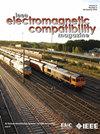Practice and Evaluation for Ceiling-Mounted MIMO Indoor Base Stations With Antenna Optimization and SAR Touch Compliance
IF 2
3区 计算机科学
Q3 ENGINEERING, ELECTRICAL & ELECTRONIC
IEEE Transactions on Electromagnetic Compatibility
Pub Date : 2024-12-18
DOI:10.1109/TEMC.2024.3511700
引用次数: 0
Abstract
Antenna design for indoor base stations (BSs) needs to consider various requirements to maximize the performance of the entire system in complicated environments. In this article, antenna design and performance evaluation are conducted from a holistic perspective using a modified multiplexing efficiency. This metric considers power constraints due to electromagnetic field exposure compliance and indoor channel environments for multiple-input multiple-output (MIMO) antenna systems. In the case study, using the reference monopole antenna, the accepted power needs to be reduced from 0.5 to 0.28 W to achieve specific absorption rate (SAR) touch compliance, resulting in a reduction in the modified multiplexing efficiency. The improved monopole antenna design can meet SAR touch compliance with an accepted power of 0.5 W by altering the electric current distribution on the monopole and ground plane. The system performance evaluated using the modified multiplexing efficiency is therefore improved by approximately 2.4 dB in the indoor environment for an indoor BS with four antennas. This holistic antenna design and evaluation process provides a valuable basis for comparing and optimizing MIMO antenna systems while considering SAR touch compliance and deployment scenarios for indoor BSs.天线优化与SAR触控的吸顶式MIMO室内基站实践与评价
本文章由计算机程序翻译,如有差异,请以英文原文为准。
求助全文
约1分钟内获得全文
求助全文
来源期刊
CiteScore
4.80
自引率
19.00%
发文量
235
审稿时长
2.3 months
期刊介绍:
IEEE Transactions on Electromagnetic Compatibility publishes original and significant contributions related to all disciplines of electromagnetic compatibility (EMC) and relevant methods to predict, assess and prevent electromagnetic interference (EMI) and increase device/product immunity. The scope of the publication includes, but is not limited to Electromagnetic Environments; Interference Control; EMC and EMI Modeling; High Power Electromagnetics; EMC Standards, Methods of EMC Measurements; Computational Electromagnetics and Signal and Power Integrity, as applied or directly related to Electromagnetic Compatibility problems; Transmission Lines; Electrostatic Discharge and Lightning Effects; EMC in Wireless and Optical Technologies; EMC in Printed Circuit Board and System Design.

 求助内容:
求助内容: 应助结果提醒方式:
应助结果提醒方式:


